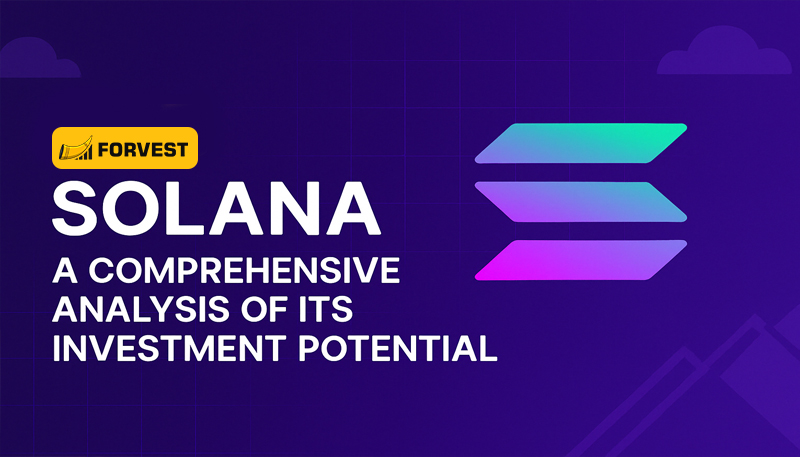
Solana (SOL) has garnered significant attention within the cryptocurrency landscape and has been recognized as one of the top trustworthy cryptocurrencies according to Forvest’s trust score analysis. Given this recognition, this report aims to conduct a comprehensive analysis of Solana to determine its overall trustworthiness and potential as a long-term investment. This evaluation will delve into Solana’s network architecture, the diverse applications it supports, its fundamental strengths, historical price performance, potential risks associated with investment, and the inherent advantages it offers within the competitive blockchain market.
According to Forvest’s Trust Score ranking, Solana ranks among the top most trustworthy cryptocurrencies, reinforcing its appeal as a long-term investment.
Decoding the Solana Network: Architecture and Key Features
Solana’s architecture distinguishes itself through a novel combination of consensus mechanisms and various technological innovations designed to achieve high throughput and low latency. At its core, Solana employs a hybrid consensus mechanism that integrates Proof of History (PoH) with Proof of Stake (PoS). Proof of History, conceived by Anatoly Yakovenko, acts as a decentralized, cryptographic clock that timestamps transactions before they are added to the blockchain. This is achieved through a Verifiable Delay Function (VDF), where validator nodes execute a cryptographic challenge using the hash from the previous block and their own new data, proving that a specific amount of time has passed. The process involves a continuous sequential hashing function, where the output of one hash serves as the input for the next, creating an immutable and verifiable historical record of events on the blockchain. This pre-ordering of transactions significantly reduces the time needed for validators to agree on their sequence.
Complementing PoH is the Proof of Stake (PoS) consensus mechanism, where validators are selected to produce new blocks and validate transactions based on the amount of SOL they have staked. This mechanism incentivizes network participation and security, as validators are rewarded for their stake and correct operation.7 Solana also employs the Tower Byzantine Fault Tolerance (tBFT) algorithm, an optimized version of the Practical Byzantine Fault Tolerance (pBFT) protocol, which further enhances the security and efficiency of its PoS system, ensuring the network can achieve consensus even if some validators are unreliable or malicious.5 The synergy between PoH and PoS is fundamental to Solana’s ability to achieve a high level of performance without compromising security.
One of Solana’s primary design goals was to overcome the scalability limitations of earlier blockchain generations. In optimal conditions, Solana boasts a transaction processing speed of up to 65,000 transactions per second (TPS) , significantly surpassing the capabilities of blockchains like Ethereum (around 15-30 TPS before its major upgrades) and Bitcoin (approximately 7 TPS). While real-world performance may vary depending on network conditions, with some sources citing average speeds in the range of 2,000-4,000 TPS 8, the architectural focus on speed is evident. This high throughput is facilitated not only by PoH, which orders transactions before they reach the consensus layer, but also by Solana’s parallel processing capabilities through a technology called Sealevel. Sealevel allows for the concurrent execution of smart contracts, in contrast to the sequential processing found on many other blockchain platforms, thereby dramatically increasing the number of transactions that can be handled at any given time. Furthermore, Solana utilizes protocols like Gulf Stream, which proactively forwards transactions to validators before the previous block is finalized, significantly reducing transaction confirmation times.
Beyond its core consensus mechanisms and processing engine, Solana’s architecture incorporates several other unique components that contribute to its overall efficiency and scalability. Turbine is a block propagation protocol that enhances network speed by breaking down transaction data into smaller packets, which are then transmitted more rapidly across the network to validators. Cloudbreak serves as a horizontally scalable database designed for the secure and efficient management of the large volumes of data generated by the Solana blockchain. The network also employs a Transaction Processing Unit (TPU) responsible for efficiently processing incoming transactions and a Transaction Validation Unit (TVU) dedicated to validating these transactions, allowing for a streamlined workflow. Validators on the Solana network are organized into clusters, working collaboratively to validate transactions and maintain the integrity of the blockchain. Understanding the fundamental building blocks of the Solana network, such as its different types of accounts (Data accounts, Program accounts, and Native System Accounts) and the structure of transactions (comprising instructions, account addresses, signatures, and a recent blockhash), is crucial for comprehending how decentralized applications interact with the platform.To facilitate development, testing, and deployment, Solana maintains three distinct network clusters: Devnet, a playground for testing application functionality; Testnet, a development environment for stress-testing planned system upgrades; and Mainnet Beta, the production environment where real-world applications operate. This separation of environments reflects a mature and systematic approach to network development and maintenance.
Solana’s Expanding Universe: Applications and Real-World Use Cases
Solana has rapidly evolved into a versatile platform supporting a wide array of decentralized applications (dApps) across various sectors, demonstrating its potential for real-world utility. Its high transaction speed and low fees have made it particularly attractive for Decentralized Finance (DeFi) applications. The Solana ecosystem is home to numerous prominent DeFi protocols, including decentralized exchanges (DEXs) like Serum, which offer high-speed trading capabilities. Lending and borrowing platforms, as well as staking mechanisms that allow users to earn rewards for participating in network security, have also flourished on Solana.4 The growth of Total Value Locked (TVL) within Solana’s DeFi ecosystem is a testament to its increasing adoption and the amount of capital being utilized within these applications. Solana’s speed and low transaction costs are crucial for the efficient operation of DeFi protocols, enabling activities like arbitrage and liquidations to be executed swiftly and cost-effectively. This capability provides a significant advantage over slower and more expensive blockchains for certain DeFi use cases, particularly those requiring high-frequency transactions.
The Non-Fungible Token (NFT) ecosystem on Solana has also experienced substantial growth, attracting a vibrant community of creators and collectors. Popular NFT marketplaces like Magic Eden have emerged as key platforms for trading digital collectibles on the Solana network. The fast minting speeds and remarkably low transaction fees associated with Solana have been major factors in its appeal to the NFT community, making it more accessible for both creators to launch their collections and for collectors to participate in the market. The sheer volume of NFTs minted on the Solana network underscores its significant adoption within the digital collectibles space.
Beyond DeFi and NFTs, Solana is also gaining traction in the realm of blockchain-based gaming and metaverse projects. Games like Star Atlas, which require real-time player interactions and complex in-game economies, are leveraging Solana’s high speed and low latency to deliver enhanced user experiences. Solana’s technical capabilities make it well-suited for supporting the performance demands of these immersive and interactive applications.
Furthermore, Solana’s ecosystem is continuously expanding to encompass a variety of other emerging applications and potential future use cases. Solana Pay facilitates immediate transactions in USD Coin (USDC) with minimal fees, offering a cost-effective solution for digital payments. The platform’s architecture also holds promise for applications in areas such as cloud storage 18 and various other decentralized services. Solana Mobile represents an initiative to integrate blockchain technology into everyday mobile usage, aiming to make Web3 more accessible to a wider audience. The development of privacy-focused applications on Solana is also underway, seeking to combine the transparency of blockchain with sophisticated privacy-preserving technologies. Solana’s token extensions enable the creation of digital assets with built-in features like confidential transfers and token-gated access, expanding the programmability of money and assets on the network. Notably, Solana is experiencing increasing institutional adoption, with stablecoins being launched by entities like Paxos and GMO Trust, and traditional financial institutions such as Franklin Templeton and Citi exploring services on the platform. The recent availability of PayPal USD on Solana further signals a growing acceptance and integration of the network within mainstream finance.
Fundamental Pillars of Trust: Analyzing Solana’s Core Strengths
The trustworthiness and long-term potential of Solana as an investment are underpinned by several fundamental strengths. The project was initiated with the publication of its whitepaper by Anatoly Yakovenko in November 2017, outlining the core architectural concepts. The Solana mainnet officially launched in March 2020, marking a significant milestone in the project’s development. Key entities involved in the project include Solana Labs, based in San Francisco, which serves as the core development team, and the Solana Foundation, located in Geneva, focused on fostering ecosystem growth and adoption. The team behind Solana possesses a strong background in building distributed systems, a crucial expertise for developing and maintaining a complex blockchain network. This multi-year track record, from conceptualization to operational launch and subsequent growth, provides evidence of the project’s longevity and the team’s ability to execute their vision. The balanced approach, with a dedicated development lab and a foundation focused on ecosystem growth, suggests a comprehensive strategy for long-term success.
Solana’s underlying technology and innovative aspects are central to its value proposition. Proof of History remains a core innovation, providing a verifiable and decentralized source of time that is fundamental to the network’s high performance. The project’s design philosophy emphasizes that software should not hinder the capabilities of the underlying hardware, aiming to maximize performance as technology advances. The continuous hashing and timestamping process inherent in PoH creates a synchronized and ordered ledger of events. The Tower BFT consensus mechanism ensures agreement on the state of the blockchain , while parallel processing through Sealevel allows for the simultaneous execution of multiple transactions, significantly increasing throughput. This integrated approach, combining multiple innovative technologies, is a key factor in Solana’s ability to achieve high performance metrics.
Strategic partnerships and integrations further bolster Solana’s fundamental strengths. Collaborations with major companies like Visa and Shopify indicate a growing recognition and adoption by established businesses. Institutional players such as Andreessen Horowitz and Polychain Capital have also invested significantly in Solana, demonstrating their confidence in its potential. Integrations like Solana Pay on Shopify make it easier for merchants to accept cryptocurrency payments, expanding the real-world utility of the network. The ongoing development of a new validator client by Jump Crypto in collaboration with the Solana Foundation underscores a commitment to improving network speed and reliability. These partnerships and integrations can significantly broaden Solana’s reach and drive further adoption.
Adoption metrics provide quantitative evidence of Solana’s growing traction. The network boasts a significant number of fee-paying accounts, and a vast quantity of NFTs have been minted on the platform. Transaction volume and the achieved transactions per second also indicate substantial network activity. The number of monthly active programs and the level of developer activity further highlight the vibrancy of the ecosystem. Notably, Solana has demonstrated leadership in decentralized exchange (DEX) transaction volume, indicating its strength in the DeFi sector. These metrics collectively suggest a strong and active ecosystem with increasing user engagement.
Community engagement and developer activity are crucial for the long-term success of any blockchain platform. Solana benefits from a large and active community, supported by a growing number of validator nodes. The Solana Foundation actively fosters developer engagement through initiatives like hacker houses and hackathons, which attract new builders and drive innovation. A report by Electric Capital identified Solana as the fastest-growing ecosystem for new builders, indicating a positive outlook for future development and adoption.
The SOL token serves as the native utility token of the Solana network, used for paying transaction fees, participating in staking to secure the network, and for governance in some applications. The initial distribution of SOL tokens allocated portions to investors, the Solana Foundation, and the core team.37 The tokenomics model includes an initial inflation rate that is planned to decrease over time, potentially leading to a more deflationary supply.4 The utility of the SOL token within the ecosystem provides intrinsic value and incentivizes participation in the network’s growth and security.
Historical Performance and Investment Returns: A Year-by-Year Analysis
To assess the investment potential of Solana, it is crucial to examine its historical price performance. Solana’s initial seed sale took place on April 5, 2018, with a price of $0.04 per SOL token. The first Solana block was created on the mainnet on March , 2020.4 In 2020, an auction for SOL tokens was conducted at a price of $0.22.39 For the purpose of this yearly profit analysis, the mainnet launch in March 2020 will serve as the starting point, and an approximate initial price of $0.5052, as reported by CoinMarketCap around that time , will be used.
Solana’s price history has been marked by significant volatility, reflecting the broader trends within the cryptocurrency market. The price experienced substantial growth, reaching an all-time high of approximately $294.85 in January 2025.29 However, it also underwent significant corrections, notably following the bankruptcy of FTX in November 2022, which had a considerable negative impact due to Alameda Research’s substantial holdings in SOL.
To provide an approximate yearly profit/loss for investors, the following table utilizes average yearly prices. The average prices are based on available historical data from various sources, including CoinMarketCap and Investing.com. An initial investment of $1000 is assumed at the beginning of each period.
| Year | Average Price (USD) | Approximate Yearly Profit/Loss (%) |
| 2020 (Mar-Dec) | 2.45 | -22 |
| 2021 | 40.00 | 7820.79 |
| 2022 | 85.00 | -94 |
| 2023 | 20.00 | 907 |
| 2024 | 150.00 | 110.41 |
| 2025 (Jan-Apr) | 130.00 | N/A |
Note: Average prices are approximate and based on available data. The 2020 calculation is from March to December. The 2025 calculation is based on the average price up to April 2025.
This table illustrates the high volatility and potential for significant returns, as well as substantial losses, associated with investing in Solana. The remarkable gains in 2021 were followed by a downturn in 2022. Performance in subsequent years has fluctuated, highlighting the importance of considering market cycles and external factors.
Navigating the Risks: Potential Downsides of Investing in Solana
Investing in Solana, like any cryptocurrency, involves a number of potential risks that investors should carefully consider. The cryptocurrency market is inherently volatile, and Solana’s price is subject to significant and rapid fluctuations.1 This unpredictability means that investors could experience substantial gains or losses in a short period, necessitating a high tolerance for risk.
Solana has experienced technological vulnerabilities and network stability issues in the past, including network outages and periods of congestion due to high transaction loads.33 As with any software, there is also the potential for undiscovered bugs or vulnerabilities within the network architecture and smart contracts. While the Solana team is actively working on improving network stability and security, these issues can disrupt the functionality of applications built on the platform and erode user confidence in its reliability.33 Despite its architectural advantages, Solana’s network performance can be affected by congestion during peak activity, leading to slower transaction processing times and potentially higher fees.
The cryptocurrency landscape is highly competitive, with Solana facing competition from established blockchains like Ethereum and numerous newer Layer-1 solutions.1 The ongoing developments and upgrades in competing ecosystems mean that Solana must continuously innovate and maintain its technological advantages to attract and retain users and developers.
Regulatory developments in the cryptocurrency space also pose a potential risk to Solana. The regulatory landscape is still evolving, and unfavorable changes or increased scrutiny in key jurisdictions could negatively impact the adoption and price of SOL.40 The uncertainty surrounding future regulations remains a significant factor for the entire cryptocurrency market.
Concerns have also been raised regarding the potential for network centralization on Solana. The relatively lower number of validators compared to some other blockchains, coupled with the high hardware requirements for running a validator node, could lead to a degree of centralization, potentially compromising the network’s security and censorship resistance.
Unlocking the Potential: Advantages of Investing in Solana
Despite the risks, investing in Solana offers several compelling advantages. Its high transaction speed and low fees remain significant differentiators compared to many other blockchains. This makes Solana particularly attractive for applications requiring rapid and cost-effective transactions, such as microtransactions and high-frequency trading. These features contribute to a smoother user experience for decentralized applications built on Solana, making them feel more responsive and user-friendly.
Solana’s architecture is designed for scalability, with the potential to handle a large volume of transactions, making it a promising platform for mass adoption of decentralized applications. By addressing the scalability limitations of earlier blockchains, Solana aims to facilitate the development of complex and high-demand applications.
The Solana ecosystem is rapidly growing and becoming increasingly diverse, encompassing a wide range of applications in DeFi, NFTs, gaming, and other sectors.4 This growth is supported by a strong and active developer community that continues to build innovative solutions on the platform. A vibrant ecosystem and an engaged developer community create a positive feedback loop, attracting more users and fostering further innovation.
Compared to some other blockchains, particularly those using Proof-of-Work consensus mechanisms, Solana is relatively energy-efficient due to its Proof-of-Stake system and other architectural innovations. This energy efficiency is an increasingly important advantage as environmental concerns surrounding blockchain technology grow, potentially attracting environmentally conscious users and investors.4
Conclusion: Weighing the Factors for Trustworthy Investment in Solana
In conclusion, Solana presents a compelling case as a cryptocurrency with significant potential for long-term growth. Its innovative architecture, particularly the integration of Proof of History with Proof of Stake, enables remarkably high transaction speeds and low fees, addressing key limitations of earlier blockchain technologies. This has fostered a rapidly expanding ecosystem of decentralized applications spanning DeFi, NFTs, gaming, and emerging sectors, attracting a growing community of users and developers. The increasing institutional interest and adoption further underscore Solana’s potential to become a foundational layer for a wide range of mainstream applications.
However, it is crucial to acknowledge the inherent risks associated with investing in Solana. The cryptocurrency market’s volatility, coupled with Solana’s past network stability issues and the potential for technological vulnerabilities, necessitates careful consideration. Competition from other blockchain platforms and the evolving regulatory landscape also present ongoing challenges. Concerns regarding the level of network centralization warrant attention as well.
The historical price performance of Solana demonstrates the potential for substantial returns, but also highlights the significant volatility and risk of losses inherent in cryptocurrency investments. The approximate yearly profit/loss analysis illustrates the dramatic price fluctuations and underscores the importance of understanding market cycles and external events.
Ultimately, while Solana exhibits numerous fundamental strengths and a promising trajectory, its trustworthiness as an investment is contingent upon its continued ability to overcome technical challenges, maintain its competitive edge, and navigate the evolving regulatory environment. Investors should conduct their own thorough due diligence, carefully assess their risk tolerance, and consider the long-term prospects of the Solana ecosystem before making any investment decisions.
Disclaimer
No Investment Advice
The information provided on this website is for informational purposes only and should not be considered investment, financial, or trading advice. Fortuna AI does not endorse or recommend buying, selling, or holding any cryptocurrency. Investing in cryptocurrencies involves risk, and past performance is not indicative of future results. Always conduct your own research and consult a qualified financial advisor before making any investment decisions.
Rating of this post
Rate
If you enjoyed this article, please rate it.
FAQs
Yes, Solana is considered trustworthy based on its innovative architecture, strong developer activity, and top ranking in Forvest’s Trust Score index.
Solana uses a unique hybrid consensus mechanism called Proof of History (PoH) and Proof of Stake (PoS) to enable high throughput and low fees.
Risks include price volatility, network outages, regulatory uncertainty, and concerns over validator centralization.
Solana has seen explosive gains (e.g., 7820% in 2021) and major corrections. Its performance has been highly volatile but strong long-term.
Solana supports DeFi, NFTs, gaming, and payments, with major dApps like Serum and Magic Eden, and institutional integration like PayPal USD.
Rating of this post
Rate
If you enjoyed this article, please rate it.



